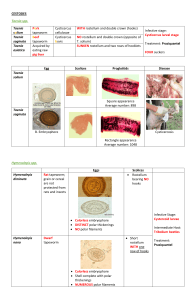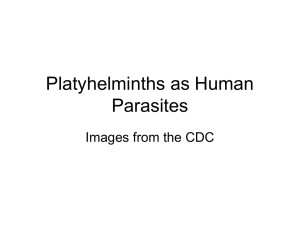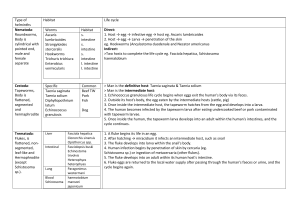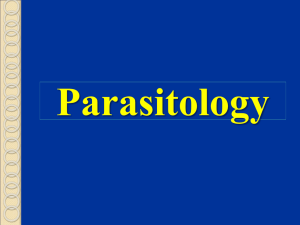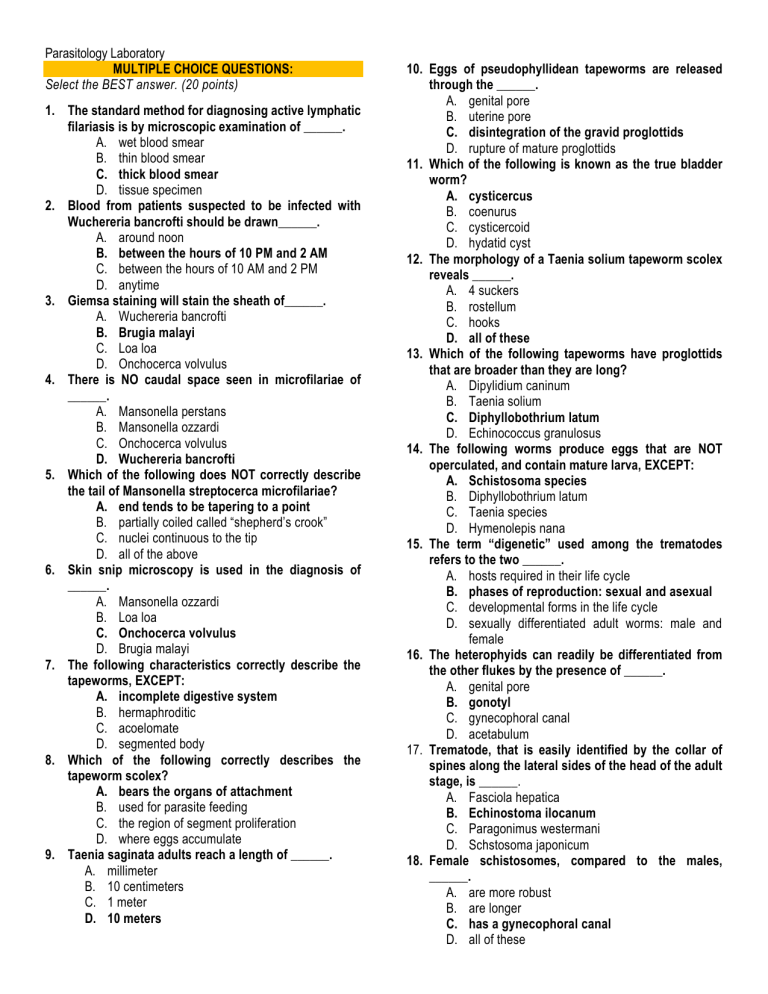
Parasitology Laboratory MULTIPLE CHOICE QUESTIONS: Select the BEST answer. (20 points) 1. The standard method for diagnosing active lymphatic filariasis is by microscopic examination of ______. A. wet blood smear B. thin blood smear C. thick blood smear D. tissue specimen 2. Blood from patients suspected to be infected with Wuchereria bancrofti should be drawn______. A. around noon B. between the hours of 10 PM and 2 AM C. between the hours of 10 AM and 2 PM D. anytime 3. Giemsa staining will stain the sheath of______. A. Wuchereria bancrofti B. Brugia malayi C. Loa loa D. Onchocerca volvulus 4. There is NO caudal space seen in microfilariae of ______. A. Mansonella perstans B. Mansonella ozzardi C. Onchocerca volvulus D. Wuchereria bancrofti 5. Which of the following does NOT correctly describe the tail of Mansonella streptocerca microfilariae? A. end tends to be tapering to a point B. partially coiled called “shepherd’s crook” C. nuclei continuous to the tip D. all of the above 6. Skin snip microscopy is used in the diagnosis of ______. A. Mansonella ozzardi B. Loa loa C. Onchocerca volvulus D. Brugia malayi 7. The following characteristics correctly describe the tapeworms, EXCEPT: A. incomplete digestive system B. hermaphroditic C. acoelomate D. segmented body 8. Which of the following correctly describes the tapeworm scolex? A. bears the organs of attachment B. used for parasite feeding C. the region of segment proliferation D. where eggs accumulate 9. Taenia saginata adults reach a length of ______. A. millimeter B. 10 centimeters C. 1 meter D. 10 meters 10. Eggs of pseudophyllidean tapeworms are released through the ______. A. genital pore B. uterine pore C. disintegration of the gravid proglottids D. rupture of mature proglottids 11. Which of the following is known as the true bladder worm? A. cysticercus B. coenurus C. cysticercoid D. hydatid cyst 12. The morphology of a Taenia solium tapeworm scolex reveals ______. A. 4 suckers B. rostellum C. hooks D. all of these 13. Which of the following tapeworms have proglottids that are broader than they are long? A. Dipylidium caninum B. Taenia solium C. Diphyllobothrium latum D. Echinococcus granulosus 14. The following worms produce eggs that are NOT operculated, and contain mature larva, EXCEPT: A. Schistosoma species B. Diphyllobothrium latum C. Taenia species D. Hymenolepis nana 15. The term “digenetic” used among the trematodes refers to the two ______. A. hosts required in their life cycle B. phases of reproduction: sexual and asexual C. developmental forms in the life cycle D. sexually differentiated adult worms: male and female 16. The heterophyids can readily be differentiated from the other flukes by the presence of ______. A. genital pore B. gonotyl C. gynecophoral canal D. acetabulum 17. Trematode, that is easily identified by the collar of spines along the lateral sides of the head of the adult stage, is ______. A. Fasciola hepatica B. Echinostoma ilocanum C. Paragonimus westermani D. Schstosoma japonicum 18. Female schistosomes, compared to the males, ______. A. are more robust B. are longer C. has a gynecophoral canal D. all of these Parasitology Laboratory 19. The observation of embryonic flame cell activity is recommended to demonstrate the viability of the eggs of ______. A. Taenia species B. Schistosoma species C. Fasciola / Fasciolopsis D. Clonorchis / Opisthorchis 20. Spot urine samples to be examined for Schistosoma haematobium should be collected ______. A. at daylight B. between noon and 3 PM C. between 10 PM and 2 AM D. anytime CORRELATION TEST: 2PTS EACH Refer to the images (note: images NOT shown to scale). Answer the questions or complete the statements using the following key outline. (30 points) 23. This is the diagnostic form of parasite that can be isolated in: 1. blood; 2. Urine A = if only option 1 is correct B = if only option 2 is correct C = if BOTH are correct D = if NONE is correct 24. This is a tapeworm scolex. Select the morphologic characteristic of the gravid proglottid of this species. 1. have genital pores on the same side of the strobila; 2. have central, rosette-shaped uterus 21. This is a microfilaria of a parasite that: 1. affects people in the Philippines; 2. may occur as nocturnally subperiodic in the Pacific Region A = if only option 1 is correct B = if only option 2 is correct C = if BOTH are correct D = if NONE is correct 22. This test system, which can be attached to a syringe, depending on the clinical specimen, is useful for the recovery of: 1. microfilariae; 2. Schistosoma haematobium A = if only option 1 is correct B = if only option 2 is correct C = if BOTH are correct D = if NONE is correct A = if only option 1 is correct B = if only option 2 is correct C = if BOTH are correct D = if NONE is correct 25. Finding these eggs in the feces of man is diagnostic. The laboratory report shall indicate: 1. Echinococcus eggs; 2. Taenia eggs A = if only option 1 is correct B = if only option 2 is correct C = if BOTH are correct D = if NONE is correct Parasitology Laboratory 26. This is an image of a structure obtained from stool specimen after india ink injection procedure. Which of the following statements is correct? 1. Parasitic infection is caused by Taenia saginata.; 2. Finding this structure is a necessary tool in checking the results of antihelminthic treatment of tapeworms. A = if only option 1 is correct B = if only option 2 is correct C = if BOTH are correct D = if NONE is correct 27. Finding this parasitic stage in man is associated with: 1. Taenia saginata; 2. Taenia solium A = if only option 1 is correct B = if only option 2 is correct C = if BOTH are correct D = if NONE is correct 29. Which of the following correctly describes the parasite shown? 1. Adult worm inhabits the intestines of man.; 2. Diagnosis of human infections is based on identification of eggs in stool. A = if only option 1 is correct B = if only option 2 is correct C = if BOTH are correct D = if NONE is correct 30. This egg, measuring about 140 by 70 μm, was seen in the saline wet preparation examination of stool from a patient who presented to the physician with jaundice and right upper quadrant pain. The adult worm can be readily differentiated from another worm that is morphologically similar by their: 1. branched testes in tandem; 2. conical shoulder on the anterior A = if only option 1 is correct B = if only option 2 is correct C = if BOTH are correct D = if NONE is correct 28. Recovery and identification of this characteristic egg is the basis for the diagnosis of a parasite that: 1. has a scolex with retractable rostellum with one single circle of between 20 and 30 hooks and a tetrad of suckers; 2. is considered as the smallest tapeworm infecting man A = if only option 1 is correct B = if only option 2 is correct C = if BOTH are correct D = if NONE is correct 31. This trematode stage develops to sexual maturity in the: 1. biliary passages; 2. small intestines Parasitology Laboratory A = if only option 1 is correct B = if only option 2 is correct C = if BOTH are correct D = if NONE is correct 32. This is a parasite egg found in stool. Which examination technique may apply? 1. Zinc sulfate flotation method is recommended for its recovery.; 2. Examine and identify using the 10x (low-power) objective. 34. In which specimen may this characteristic egg be found? 1. sputum; 2. Urine A = if only option 1 is correct B = if only option 2 is correct C = if BOTH are correct D = if NONE is correct 35. Which of the following correctly describe/s adults of this parasite? 1. The ovary in female is on the anterior half of the body.; 2. Males have finely tuberculated tegument. A = if only option 1 is correct B = if only option 2 is correct C = if BOTH are correct D = if NONE is correct 33. Which of the following correctly describes the eggs laid by this parasite? 1. can be detected in the sputum and the stool; 2. has a “seated” operculum and knob at the abopercular end A = if only option 1 is correct B = if only option 2 is correct C = if BOTH are correct D = if NONE is correct MAGNITUDE TEST” 2 POINTS EACH Compare A and B based on the criterion given. Answer using the key outline below. (20 points) 36. Width of the microfilaria: A. Wuchereria bancrofti; B. Mansonella perstans A = if only option 1 is correct B = if only option 2 is correct C = if BOTH are correct D = if NONE is correct A = if A is greater than B B = if B is greater than A C = if A and B are equal 37. Number of acetabula in the scolex: A. pork tapeworm; B. dog tapeworm A = if A is greater than B B = if B is greater than A C = if A and B are equal 38. Number of proglottids comprising the strobila: A. Diphyllobothrium latum; B. Echinococcus granulosus A = if A is greater than B B = if B is greater than A C = if A and B are equal Parasitology Laboratory 39. Number of ovarian lobe/s in a segment: A. Taenia saginata; B. Taenia solium A = if A is greater than B B = if B is greater than A C = if A and B are equal 40. Number of complete set/s of male and female reproductive systems: A. Echinococcus granulosus; B. Dipylidium caninum A = if A is greater than B B = if B is greater than A C = if A and B are equal 41. Number of scolices in the cyst: A. cysticercoid; B. cysticercus A = if A is greater than B B = if B is greater than A C = if A and B are equal 42. Number of lateral uterine branches in each gravid proglottid: A. Taenia saginata; B. Taenia solium A = if A is greater than B B = if B is greater than A C = if A and B are equal 43. Number of testes in the adult: A. Fasciolopsis buski; B. Echinostoma ilocanum A = if A is greater than B B = if B is greater than A C = if A and B are equal 44. Number of testes the in adult worm: A. Schistosoma japonicum; B. Schistosoma mansoni A = if A is greater than B B = if B is greater than A C = if A and B are equal 45. Number of eggs in the uterus: A. vesical blood fluke; B. oriental blood fluke A = if A is greater than B B = if B is greater than A C = if A and B are equal IDENTIFICATION: 2POINTS EACH Identify the TEST METHOD described in the following and cite a PARASITE associated with it. (10 points) 46. An oral test dose of 50 mg diethylcarbamazine results in intense pruritus within 2 hours. Mazzotti reaction- Onchocerca volvulus 47. An immediate hypersensitivity skin test involving intradermal injection of sterilized fluid from hydatid cysts Casoni’s intradermal test- Echinococcus granulosus 48. Concentration procedure using blood and dilute formalin Knott’s concentration method- Wuchereria bancrofti 49. Formation of blebs of precipitates around the eggs in the presence of immune serum Circumoval Precipitin Test- Schistosoma species 50. Blood is lyzed and passed through a 5-μm polycarbonate filter and subsequently stained Membrane Filtration Technique- Mansonella streptocerca
